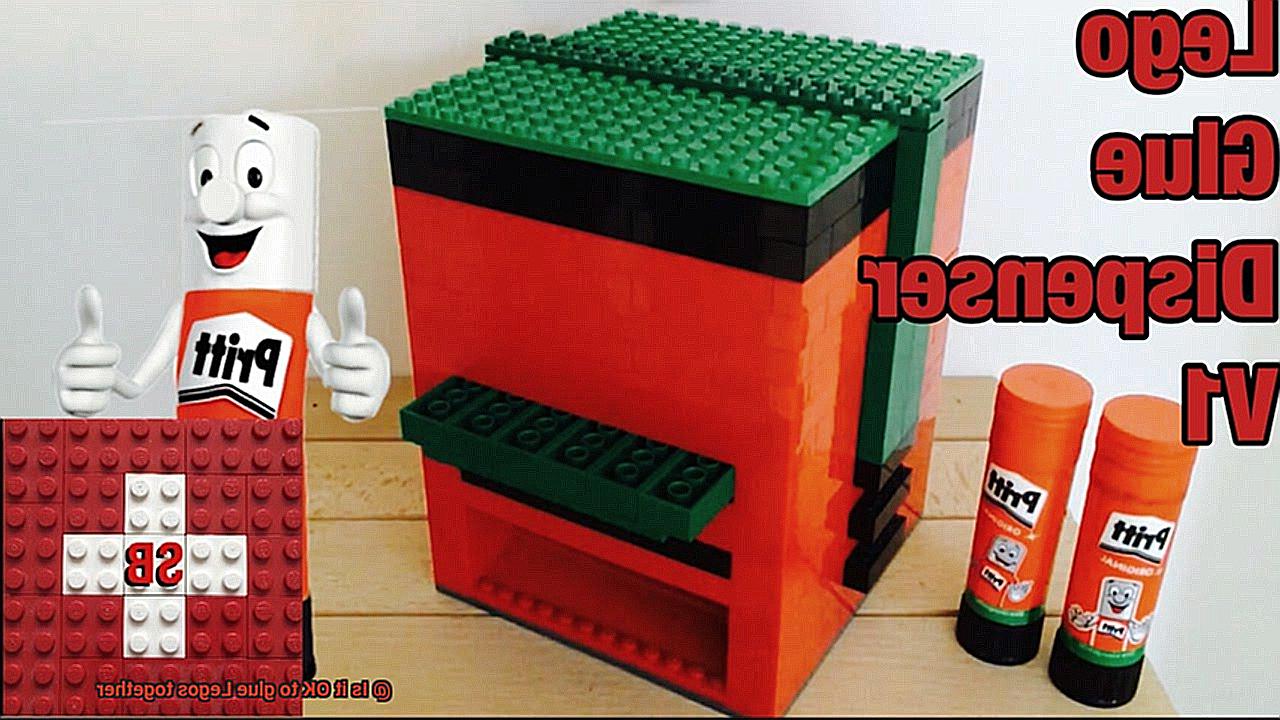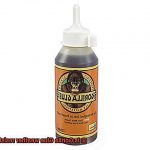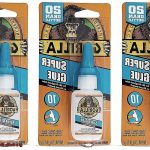Those colorful bricks that ignite the fires of imagination and transport us to a world of endless possibilities. We’ve all been there, building towering castles and epic spaceships, only to see them crumble with the slightest touch. And so, the age-old debate ensues: is it sacrilege or salvation to glue Legos together?
In this blog post, we’ll dive headfirst into the pros and cons of wielding that sticky adhesive, exploring how it affects creativity, safety, and building techniques. Some argue that gluing preserves our masterpieces for eternity, while others claim it undermines the very essence of these iconic toys. So let’s explore both sides of this sticky situation and arm ourselves with knowledge.
As we embark on this journey, let’s strike a balance between preserving our beloved creations and embracing the fluidity that makes Lego so special. Are you ready? Grab your glue (or not) as we unravel the tangled web surrounding the glue vs. no glue conundrum.
Pros of Glueing Legos Together
Contents
When it comes to building with Legos, the possibilities are endless. However, some builders may find that their creations lack stability or durability, especially during rough play or transportation. In these cases, gluing Legos together can be a beneficial solution. In this article, we will explore the advantages of glueing Legos together, including enhanced stability, prevention of lost pieces, improved aesthetic appeal, ease of display and transportation, functional use, and preservation of sentimental value. While gluing Legos is a topic of debate among enthusiasts and collectors, understanding the pros of glueing can help you make an informed decision for your own Lego creations.
Enhanced Stability and Durability:
One of the main advantages of glueing Legos together is the added stability and durability it provides. By permanently attaching the pieces, you can ensure that your creation remains intact even during rough play or accidental bumps. This is particularly beneficial for intricate designs or large-scale projects that may be more prone to falling apart. Glueing Legos together allows you to enjoy your creation for a longer period without worrying about it crumbling.
Prevention of Lost Pieces:
Have you ever spent hours searching for that one missing Lego piece? Glueing Legos together can help minimize the risk of losing small parts. When Legos are not glued together, it’s common for pieces to become separated from the main structure and go missing. By permanently attaching them, you can ensure that your entire creation stays together and can be enjoyed as intended.
Improved Aesthetic Appeal:
Glueing Legos together can enhance the visual appeal of your creations. When building complex designs or elaborate structures, it can be challenging to keep everything in place without the use of glue. By permanently attaching the pieces, you have more freedom to explore intricate designs and create visually stunning creations. Glueing can help you achieve the desired look and maintain the integrity of your artistic vision.
Ease of Display and Transportation:
If you want to showcase your Lego creations, gluing them together can make it easier to transport and display them without worrying about any parts falling off or getting damaged. This is particularly helpful for large-scale projects or delicate designs that require extra support. Glued Legos offer peace of mind when exhibiting your creations at conventions, galleries, or even in your own home.
Functional Use:
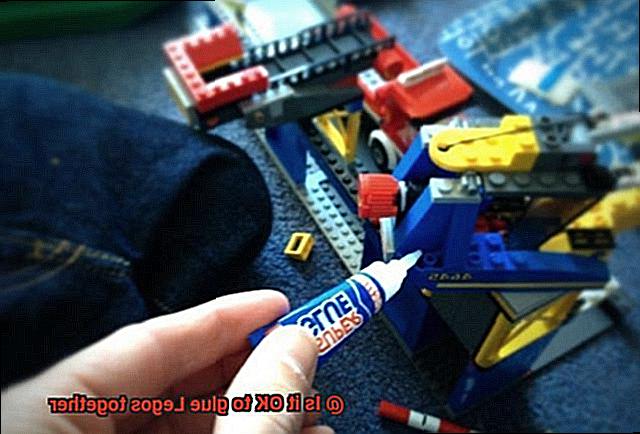
Glued Legos can serve as functional objects beyond just toys. Some people use Lego creations to build custom furniture or household items. Gluing Legos together provides the necessary strength and stability for these practical applications, making them more reliable and durable. Imagine having a coffee table made entirely of Legos that can withstand everyday use.
Cons of Glueing Legos Together
Before you reach for that glue bottle to preserve and enhance your creations, take a moment to ponder the potential drawbacks that come with permanently adhering those plastic bricks. In this article, we will delve into the cons of gluing Legos together, unveiling the limitations it imposes on creativity, collectibility, playability, and the overall Lego experience.
Restricted Reusability:
One of the defining features of Lego is its endless capacity for disassembly and rebuilding. Gluing Legos together sacrifices this fundamental aspect of Lego play, curtailing your ability to explore new designs and reimagine your constructions. The loss of versatility can be disheartening for those who relish the creative freedom that Legos offer.
Devaluation of Collectibles:
For avid collectors, the value of Legos lies in their rarity and uniqueness. Gluing Legos diminishes their individuality, transforming them into mere fixed structures devoid of collector’s appeal. Think twice before reaching for that glue bottle if you cherish the thrill of hunting down rare Lego sets or pieces.
Frustrating Inflexibility:
Construction mistakes happen, especially when experimenting with new designs. Gluing Legos makes rectifying errors or tweaking designs a Herculean task. Without the ease of disassembly and reassembly, frustration can ensue, particularly for younger builders still honing their skills.
Potential Damage:
The gluing process itself poses risks to Lego pieces. Adhesive residue and marks can mar the plastic surface, making it challenging to restore them to their original state. Moreover, certain adhesives may contain chemicals that degrade or warp the plastic over time, compromising the integrity of your beloved Legos.
Limiting Play Possibilities:
Lego play is synonymous with imaginative possibilities as children build and rebuild an array of structures, vehicles, and scenes. Gluing Legos curtails this creative freedom, inhibiting the modification or transformation of glued structures into new creations. The joy of spontaneous play is stifled, and the potential for endless exploration is lost.
Betraying the Lego Philosophy:
At its core, Lego champions open-ended play, encouraging problem-solving, critical thinking, and spatial awareness. Gluing Legos contradicts this philosophy by constraining the modular nature that fosters these essential skills. Engaging in glueing may inadvertently hinder the educational benefits inherent in Lego play.
Preservation of Delicate or Intricate Builds
Are you pondering the wisdom of gluing your delicate or intricate Lego builds? Fear not, my friends, for I have compiled all the information you need to make an informed decision. So let us embark on this journey together, exploring the art of preserving our masterpieces.
To begin, let us delve into the advantages of gluing Legos together. Picture this: delicate builds standing tall, unyielding to the chaos of playtime. Intricate creations, their small pieces safeguarded from the abyss of loss. Gluing Legos offers stability and protection, ensuring your masterpiece remains intact and can be proudly displayed without a tinge of worry.
Ah, stability, the foundation of every great structure. Gluing Legos keeps the individual pieces in place, preventing them from shifting or falling apart. This is especially crucial for fragile designs with complex structures or requiring precise positioning. With glue as your ally, rest easy knowing that your creation won’t crumble or break apart easily.
But protection is not far behind. Lego bricks are designed for assembly and disassembly but constant handling and play can wear them down. Gluing the pieces together creates a formidable structure that can withstand rougher handling. Imagine your beloved build showcased in a high-traffic area or handled by enthusiastic children who may not be as careful with delicate creations. Fear not, for the glue shall shield it from harm.
Yet, as with all things in life, there are downsides to consider. Once glued, the bricks become steadfast, making modification or rebuilding a challenge. The lack of flexibility may dampen your creative spirit if you enjoy experimenting with different designs or seek to reuse the bricks for future projects.
And let us not forget about value. Lego sets and bricks hold immense collectible worth. Some enthusiasts prefer to keep their pieces in pristine condition, unaltered by glue’s binding embrace. Gluing them together alters their value and limits their potential for resale or trade.
Should you choose to embark on the path of gluing, tread carefully, my friends. Seek the right adhesive, for regular household glues may not provide a lasting bond and could leave residue or damage the bricks. Specialized Lego adhesives, designed explicitly for brick bonding, offer optimal strength while ensuring the safety of your beloved Legos.
Alternatively, explore the realm of removable adhesives, such as museum putty or sticky tack. These magical companions secure your build temporarily without permanently altering the Legos. They hold steadfast for display purposes yet can be easily removed when the winds of change blow through your creative spirit.
Permanent Displays and Installations
Permanent displays and installations are creations made with Lego bricks that are intended to be kept intact for an extended period of time. These displays can range from small-scale models to large-scale installations, and they often require a higher level of structural integrity and stability. Gluing Legos together is a controversial practice among Lego purists, as it goes against the traditional concept of Lego building, which emphasizes creativity, versatility, and the ability to take apart and rebuild creations.
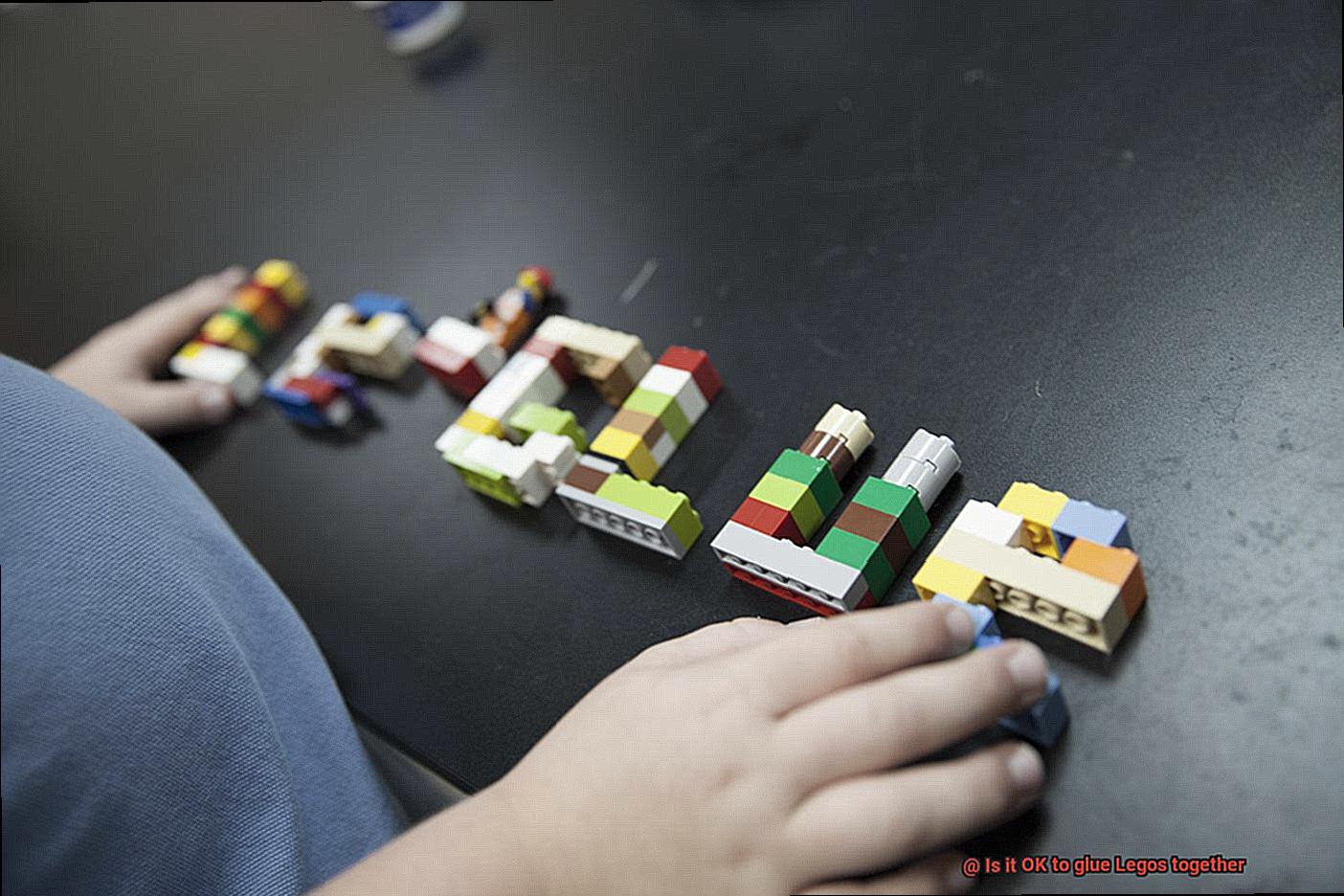
However, there are advantages to gluing Legos together for permanent displays and installations. Firstly, gluing adds stability and durability to the creation, preventing accidental disassembly or damage. This is especially important for large-scale or complex designs that may be subjected to movement or handling. By gluing the Legos together, the creation remains intact and secure.

Another benefit of gluing Legos together is preservation. Over time, Lego pieces can loosen or discolor due to wear and tear. By gluing them together, you can better preserve your creation’s original appearance. This is particularly significant for displays that will be exhibited in public spaces or transported frequently. The adhesive holds the pieces securely in place, reducing the risk of damage during transportation or accidental disassembly by viewers.
However, there are also disadvantages to gluing Legos together. Firstly, it goes against the philosophy of LEGO itself. LEGO believes in encouraging imagination, creativity, and free building, and does not endorse or recommend gluing their bricks together. Gluing also limits the ability to modify or repurpose the creation in the future, as the pieces cannot be easily separated without causing damage.
Reuse and Versatility Limitations
It may seem like a good idea at first, but gluing Legos comes with its fair share of limitations. In this blog post, we will explore the drawbacks of using glue to join Legos together, diving into the reasons why it hampers their versatility and reuse potential.
Restricted Reusability:
The beauty of Legos lies in their ability to be disassembled and reconfigured into various shapes and structures. Gluing Legos together goes against this fundamental principle, making it difficult to take them apart and reuse them for different creations. Once glued, the pieces become permanently attached, limiting their potential for imaginative play. The joy of building and rebuilding is lost when Legos are glued together.
Design Modifications:
Gluing Legos also hampers the ability to modify or make changes to a design. Imagine wanting to add or remove a piece from a glued structure – it becomes nearly impossible without damaging the entire creation. This lack of flexibility stifles creativity and inhibits the exploration of new ideas. The dynamic nature of Legos is compromised when they are permanently glued.
Limited Play Scenarios:
Gluing Legos together can limit their usefulness in other play scenarios. For example, if a child wants to use the same Lego bricks for a spaceship today and a castle tomorrow, gluing them together would make it impossible to repurpose the bricks for different imaginative play. The versatility that Legos offer is compromised by permanent gluing, restricting the range of play possibilities.
Decreased Lifespan:
Another downside of gluing Legos is that it reduces the lifespan of the pieces. Over time, glued connections can weaken or break, rendering the Lego set useless. Conversely, non-glued Legos can be disassembled, cleaned, and reused for generations. Gluing Legos limits their durability and longevity.
Lego’s Official Stance:
It is essential to consider the advice of the Lego company itself. The official Lego website advises against permanently attaching bricks together using glue or any other adhesive as it contradicts the open-ended play experience that Legos are designed to provide. The Lego company understands the importance of preserving the core principles of Lego play.
Open-Ended Nature of Lego Play
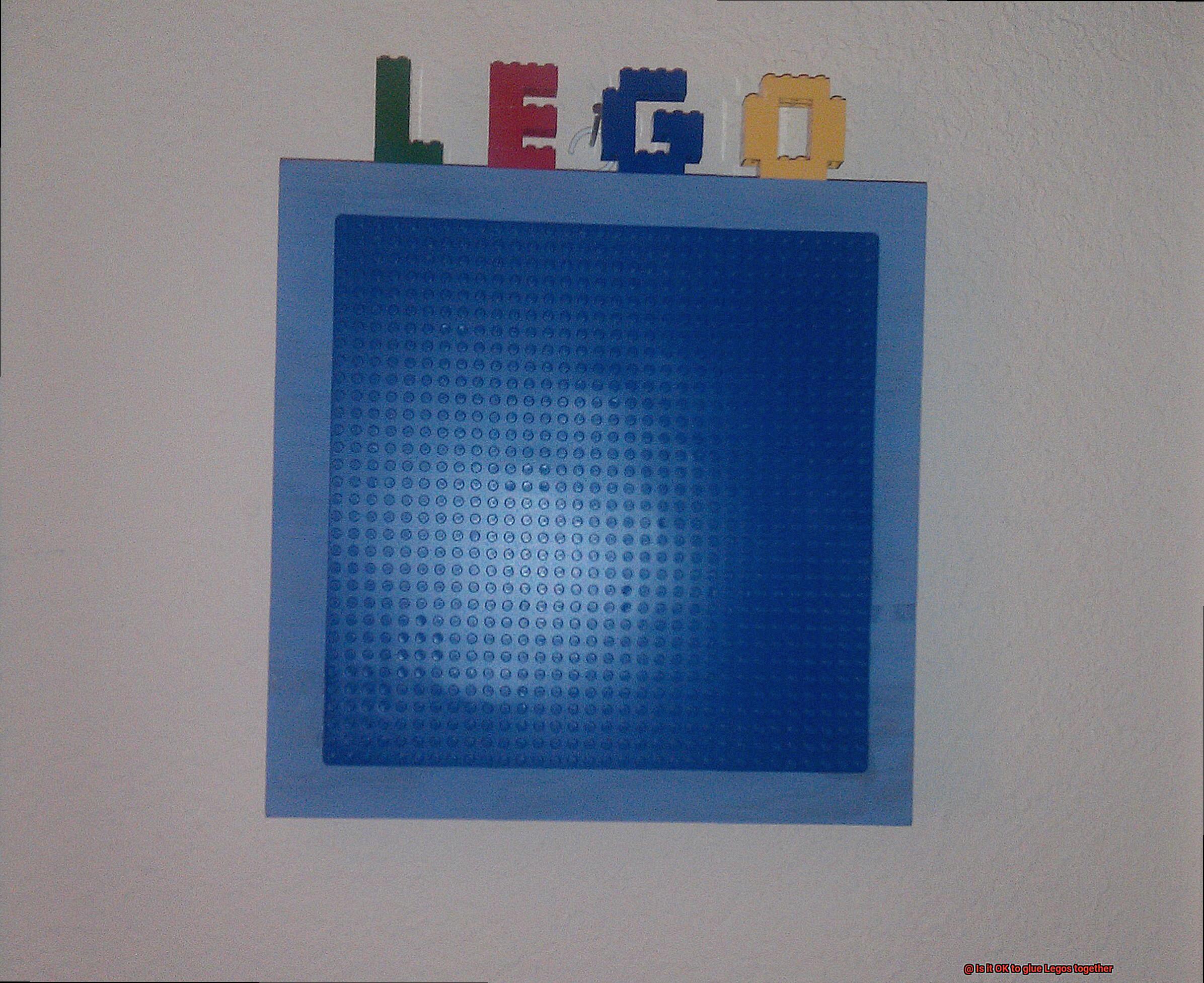
Lego bricks have captivated the hearts and minds of children and adults worldwide for decades, thanks to their open-ended nature. This blog post delves into the limitless possibilities of Lego play and how it fosters creativity, problem-solving, social interaction, and continuous learning.
The Power of Imagination:
Lego bricks offer an infinite number of possibilities, setting them apart from toys with predetermined purposes. With Lego play, children are encouraged to dream big and unleash their imagination. Whether constructing towering castles or futuristic spaceships, Lego play allows children to express their individuality and create something truly unique.
Building Problem-Solving Skills:
While Lego sets often come with instructions, they also provide extra pieces that promote customization. This open-endedness challenges children to think critically and problem-solve. As they experiment with different brick combinations, they learn about balance, symmetry, and spatial reasoning. Overcoming challenges, such as stabilizing a wobbly structure, builds resilience and perseverance.
Social Interaction and Collaboration:
Lego play extends beyond solitary endeavors; it fosters social interaction and collaboration. When children engage in Lego play together, they learn valuable skills such as collaboration, negotiation, and sharing ideas. Communication skills are developed as they explain their creations and listen to others’ perspectives. Collaborative play promotes teamwork and cooperation, essential skills for success in school and beyond.
Continuous Learning Opportunities:
Lego play offers endless learning opportunities as children grow and develop new interests and skills. They can incorporate evolving knowledge into their creations, showcasing their understanding of various subjects. From engineering principles to architectural concepts, Legos can adapt to reflect changing interests. This adaptability ensures that Legos remain engaging and relevant throughout childhood.
Impact on Collectors and Resale Value
Today, we delve into a topic that has ignited debates within the Lego community – gluing Legos together. While it may seem like a practical solution for stability or preservation, let’s explore the far-reaching implications of this action on collectors and the resale value of Lego sets.
Collectability and Desirability:
Collectors, avid seekers of Lego sets, yearn for pristine condition treasures. However, glue residue or altered pieces can render these sets less desirable, tarnishing their allure. Moreover, gluing Legos restricts the potential for future building possibilities, stifling the appeal for creative builders who crave limitless creation.
Marketability and Buyer Hesitation:
The marketability of glued Lego sets takes a hit as collectors prefer the original experience of building with individual pieces. Potential buyers often hesitate to acquire glued sets due to concerns about authenticity and alterations. The glue becomes an unwanted interloper in the realm of pure Lego craftsmanship.
Identification Challenges:
Glued Legos present a perplexing challenge when it comes to identifying specific pieces or parts of a set. This conundrum impedes collectors seeking complete or replacement sets, casting a shadow on the satisfaction they seek in their Lego quests.
Acceptable Situations:
In certain contexts, gluing Legos is deemed acceptable by some. Permanent displays or dioramas benefit from stability and longevity ensured by glue. However, caution must be exercised even in these cases, as glued displays may pose difficulties when it comes to dismantling without causing unintended damage.
Long-term Implications:
Glued Lego displays may entrap collectors and buyers in a web of limitations. Their permanence hinders future options for collectors who seek to explore different configurations or sell their collections to other enthusiasts. The adhesive bond becomes a stubborn barrier to the fluidity and adaptability that Legos are renowned for.
zjqonu2_Tf4″ >
Conclusion
In conclusion, the choice to glue Legos together is a deeply personal one, dependent on your own desires and requirements. The act of gluing Legos can bestow upon them an unparalleled stability, preventing the dreaded loss of pieces and enhancing their overall aesthetic appeal. It also grants ease in displaying and transporting your creations, while serving a functional purpose and safeguarding their sentimental value. This is especially true for delicate or intricate builds that necessitate additional support or protection.
Nevertheless, it is crucial to acknowledge the drawbacks that accompany gluing Legos. It restricts their reusability and versatility, limiting your ability to modify designs as desired. It hampers the boundless possibilities for play that Lego enthusiasts hold dear, reducing the lifespan of these beloved building blocks. Furthermore, gluing Legos goes against the very essence of Lego’s philosophy itself – an ideology centered around imagination and endless creativity. Additionally, collectors may find themselves impacted by glue as it diminishes collectability, marketability, and identification within Lego sets.
Ultimately, achieving a harmonious balance between preserving your creations and embracing the open-ended nature of Lego play is paramount. If you seek temporary stability without permanently altering your Legos, consider utilizing specialized Lego adhesives or removable options such as museum putty or sticky tack.
Always remember that Lego bricks are ingeniously designed to be taken apart and reconstructed in infinite configurations. The true joy of Lego lies in the vast realm of imaginative possibilities they offer.

